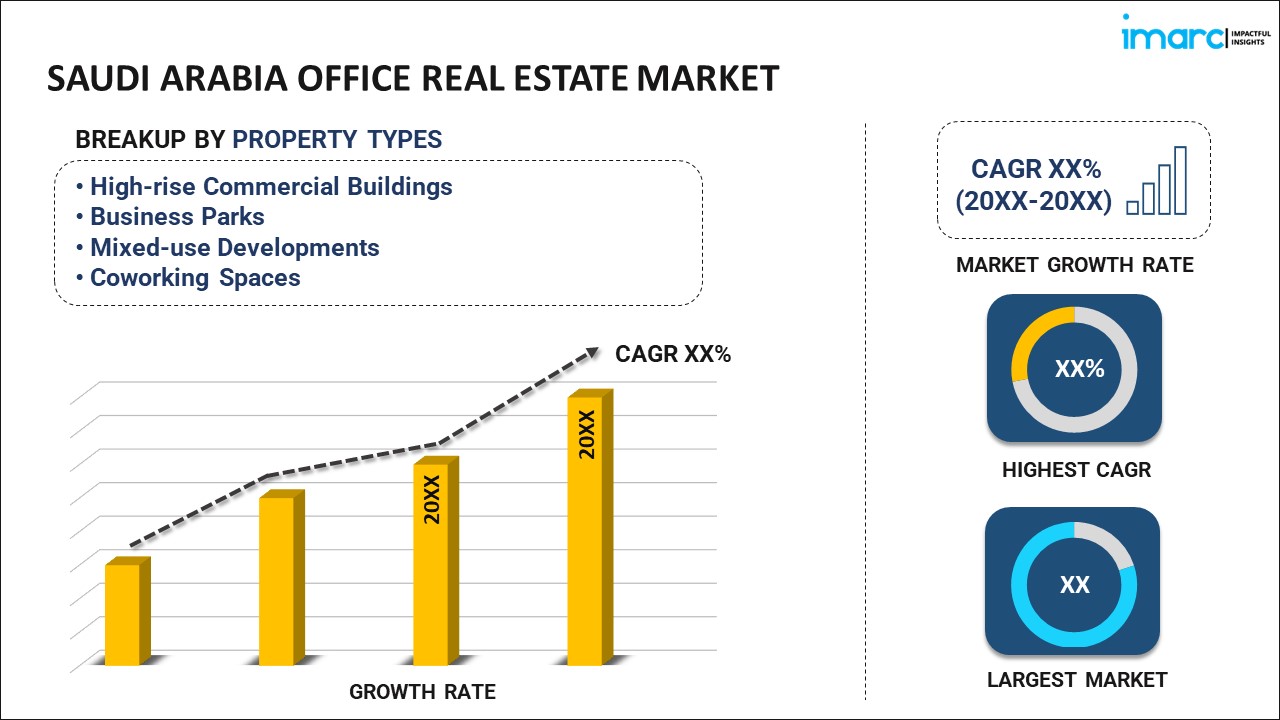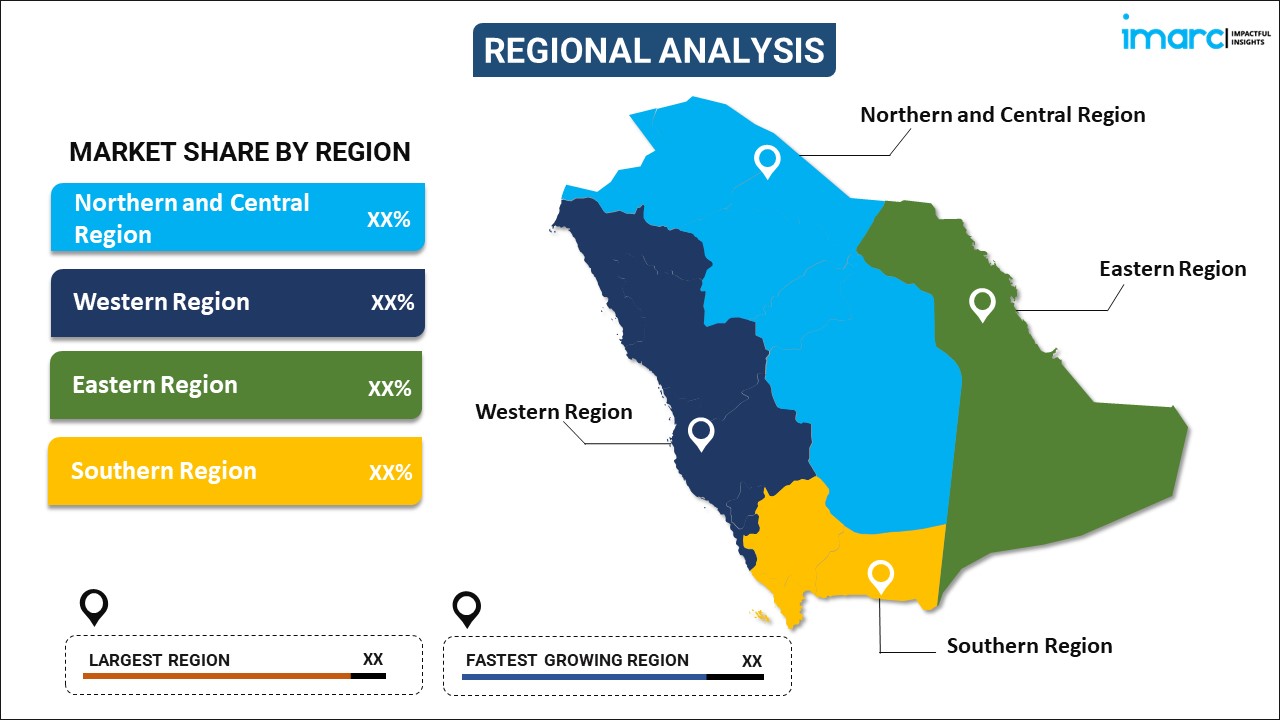
Saudi Arabia Office Real Estate Market Report by Property Type (High-rise Commercial Buildings, Business Parks, Mixed-use Developments, Coworking Spaces), Rental Model (Traditional Long-term Leases, Flexible Lease Arrangements, Coworking/Shared Office Spaces), Classification (Class A, Class B, Class C), and Region 2025-2033
Market Overview:
Saudi Arabia office real estate market size reached USD 19,490.0 Million in 2024. Looking forward, IMARC Group expects the market to reach USD 36,146.3 Million by 2033, exhibiting a growth rate (CAGR) of 7.1% during 2025-2033. The increasing urbanization, which can enhance the demand for office space in city centers that offer access to a skilled workforce, transportation infrastructure, and amenities, is primarily driving the market.
|
Report Attribute
|
Key Statistics
|
|---|---|
|
Base Year
|
2024 |
|
Forecast Years
|
2025-2033
|
|
Historical Years
|
2019-2024
|
| Market Size in 2024 | USD 19,490.0 Million |
| Market Forecast in 2033 | USD 36,146.3 Million |
| Market Growth Rate (2025-2033) | 7.1% |
Office real estate refers to commercial properties specifically designed and utilized for conducting business operations. These spaces are purpose-built to cater to the needs of various businesses, offering functional layouts, amenities, and infrastructure to facilitate work. Office real estate can encompass a wide range of properties, including traditional office buildings, co-working spaces, and business parks. The value of office real estate is influenced by factors such as location, accessibility, size, and the quality of facilities. In urban areas, office spaces are often located in central business districts to maximize accessibility for employees and clients. They can vary in size, from small individual offices to large corporate headquarters. Investors and businesses alike often lease or purchase office real estate to establish a physical presence, accommodate employees, and project a professional image. The demand for office space can fluctuate based on economic conditions, technological advancements, and shifts in work culture, with trends like remote work and flexible scheduling influencing the way office spaces are designed and used in the modern era.
Saudi Arabia Office Real Estate Market Trends:
The office real estate market in Saudi Arabia is influenced by a myriad of factors, and understanding these drivers is crucial for both investors and developers. Firstly, economic conditions play a pivotal role. During periods of robust economic growth, businesses expand, leading to increased demand for office spaces. Furthermore, technological advancements and shifts in work culture are significant contributors. The surge in remote work and flexible arrangements has spurred companies to rethink their office needs, potentially reducing their square footage requirements. In addition to this, location remains a paramount driver. Proximity to transportation hubs, amenities, and desirable neighborhoods can significantly impact demand and rental rates. Moreover, government policies and regulations exert considerable influence. Zoning laws, tax incentives, and building codes can shape the office real estate landscape. Lastly, demographic trends, such as urbanization and population growth, can create long-term demand, particularly in vibrant metropolitan areas. In conclusion, a dynamic interplay of economic, technological, regulatory, and social factors ultimately drives the office real estate market in Saudi Arabia, necessitating adaptability and foresight from stakeholders in this sector.
Saudi Arabia Office Real Estate Market Segmentation:
IMARC Group provides an analysis of the key trends in each segment of the market, along with forecasts at the country level for 2025-2033. Our report has categorized the market based on property type, rental model, and classification.
Property Type Insights:

- High-rise Commercial Buildings
- Business Parks
- Mixed-use Developments
- Coworking Spaces
The report has provided a detailed breakup and analysis of the market based on the property type. This includes high-rise commercial buildings, business parks, mixed-use developments, and coworking spaces.
Rental Model Insights:
- Traditional Long-term Leases
- Flexible Lease Arrangements
- Coworking/Shared Office Spaces
A detailed breakup and analysis of the market based on the rental model have also been provided in the report. This includes traditional long-term leases, flexible lease arrangements, and coworking/shared office spaces.
Classification Insights:
- Class A
- Class B
- Class C
The report has provided a detailed breakup and analysis of the market based on the classification. This includes class a, class b, and class c.
Regional Insights:

- Northern and Central Region
- Western Region
- Eastern Region
- Southern Region
The report has also provided a comprehensive analysis of all the major regional markets, which include Northern and Central Region, Western Region, Eastern Region, and Southern Region.
Competitive Landscape:
The market research report has also provided a comprehensive analysis of the competitive landscape in the market. Competitive analysis such as market structure, key player positioning, top winning strategies, competitive dashboard, and company evaluation quadrant has been covered in the report. Also, detailed profiles of all major companies have been provided.
Saudi Arabia Office Real Estate Market Report Coverage:
| Report Features | Details |
|---|---|
| Base Year of the Analysis | 2024 |
| Historical Period | 2019-2024 |
| Forecast Period | 2025-2033 |
| Units | Million USD |
| Scope of the Report | Exploration of Historical Trends and Market Outlook, Industry Catalysts and Challenges, Segment-Wise Historical and Future Market Assessment:
|
| Property Types Covered | High-rise Commercial Buildings, Business Parks, Mixed-use Developments, Coworking Spaces |
| Rental Models Covered | Traditional Long-term Leases, Flexible Lease Arrangements, Coworking/Shared Office Spaces |
| Classifications Covered | Class A, Class B, Class C |
| Regions Covered | Northern and Central Region, Western Region, Eastern Region, Southern Region |
| Customization Scope | 10% Free Customization |
| Post-Sale Analyst Support | 10-12 Weeks |
| Delivery Format | PDF and Excel through Email (We can also provide the editable version of the report in PPT/Word format on special request) |
Key Questions Answered in This Report:
- How has the Saudi Arabia office real estate market performed so far and how will it perform in the coming years?
- What has been the impact of COVID-19 on the Saudi Arabia office real estate market?
- What is the breakup of the Saudi Arabia office real estate market on the basis of property type?
- What is the breakup of the Saudi Arabia office real estate market on the basis of rental model?
- What is the breakup of the Saudi Arabia office real estate market on the basis of classification?
- What are the various stages in the value chain of the Saudi Arabia office real estate market?
- What are the key driving factors and challenges in the Saudi Arabia office real estate?
- What is the structure of the Saudi Arabia office real estate market and who are the key players?
- What is the degree of competition in the Saudi Arabia office real estate market?
Key Benefits for Stakeholders:
- IMARC’s industry report offers a comprehensive quantitative analysis of various market segments, historical and current market trends, market forecasts, and dynamics of the Saudi Arabia office real estate market from 2019-2033.
- The research report provides the latest information on the market drivers, challenges, and opportunities in the Saudi Arabia office real estate market.
- Porter's five forces analysis assist stakeholders in assessing the impact of new entrants, competitive rivalry, supplier power, buyer power, and the threat of substitution. It helps stakeholders to analyze the level of competition within the Saudi Arabia office real estate industry and its attractiveness.
- Competitive landscape allows stakeholders to understand their competitive environment and provides an insight into the current positions of key players in the market.
Need more help?
- Speak to our experienced analysts for insights on the current market scenarios.
- Include additional segments and countries to customize the report as per your requirement.
- Gain an unparalleled competitive advantage in your domain by understanding how to utilize the report and positively impacting your operations and revenue.
- For further assistance, please connect with our analysts.
 Inquire Before Buying
Inquire Before Buying
 Speak to an Analyst
Speak to an Analyst
 Request Brochure
Request Brochure
 Request Customization
Request Customization




.webp)




.webp)












